A new study has identified the first known permanent population of asteroids originating from outside our Solar System. The objects are believed to have been captured from other stars billions of years ago, and have been orbiting our Sun in disguise ever since. The work is published in the journal Monthly Notices of the Royal Astronomical Society.
The first interstellar visitor, the asteroid known as ‘Oumuamua, hit the headlines in 2017, however it was just passing through. The newly-identified asteroids on the other hand are thought to have been present almost since the birth of our Solar System, 4.5 billion years ago in a star cluster where each sun had its own planets and asteroids.
“The close proximity of the stars meant that they felt each others’ gravity much more strongly in those early days than they do today,” explained Dr Fathi Namouni, lead author of the study. “This enabled asteroids to be pulled from one star system to another.”
In the new work, Dr Namouni (Observatoire de la Côte d'Azur, France) and co-author Dr Maria Helena Morais (Universidade Estadual Paulista, Brazil) ran numerical simulations to turn back the clock to the earliest days of the Solar System, producing a snapshot that allowed them to see where the asteroids were originally located.
At the time of the snapshot, the asteroids were orbiting the Sun in a distant region beyond the reach of the original Solar System disc, and also moving perpendicular to the orbital plane shared by the planets and other asteroids. These two observations indicate that the new group did not originally belong to our Solar System, but must have been captured from the interstellar medium during planet formation.
Being able to tell apart interstellar asteroids from native asteroids born in the Solar System has long eluded astronomers, but the team’s results identified 19 asteroids of interstellar origin. These are currently orbiting as part of the group of asteroids known as Centaurs, which roam the space in between the giant planets of the Solar System.
“The discovery of a whole population of asteroids of interstellar origin is an important step in understanding the physical and chemical similarities and differences between Solar System-born and interstellar asteroids,” commented Dr Morais.
She adds: “This population will give us clues about the Sun’s early birth cluster, how interstellar asteroid capture occurred, and the role that interstellar matter had in chemically enriching the Solar System and shaping its evolution.”
Media contacts
Dr Morgan Hollis
Royal Astronomical Society
Mob: +44 (0)7802 877 700
press@ras.ac.uk
Dr Robert Massey
Royal Astronomical Society
Tel: +44 (0)20 7292 3979
Mob: +44 (0)7802 877 699
press@ras.ac.uk
Science contacts
Dr Fathi Namouni
Observatoire de la Côte d'Azur
France
Mob: +33 615 47 62 65
fathi.namouni@oca.eu
Dr Maria Helena Morais
Universidade Estadual Paulista
Brazil
Images and captions
https://ras.ac.uk/media/435
The Centaurs in the study have so far not been imaged directly. Their sizes range from 10km to 300km, and small Centaurs may look like the 53km asteroid Mathilde imaged by NASA’s NEAR Shoemaker mission in 1997. Credit: NASA / NEAR Shoemaker.
https://ras.ac.uk/media/436
A stellar nursery in the Lobster Nebula (NGC6357), where star systems exchange asteroids as our Solar System is thought to have done 4.5 billion years ago. Credit: ESO / VVV Survey / D. Minniti. Acknowledgement: Ignacio Toledo
Further information
The new work appears in, “An interstellar origin for high-inclination Centaurs”, F. Namouni, M.H.M. Morais, Monthly Notices of the Royal Astronomical Society (2020), in press.
An advance copy of the paper is available from: https://doi.org/10.1093/mnras/staa712
Notes for editors
The Royal Astronomical Society (RAS), founded in 1820, encourages and promotes the study of astronomy, solar-system science, geophysics and closely related branches of science. The RAS organises scientific meetings, publishes international research and review journals, recognises outstanding achievements by the award of medals and prizes, maintains an extensive library, supports education through grants and outreach activities and represents UK astronomy nationally and internationally. Its more than 4,400 members (Fellows), a third based overseas, include scientific researchers in universities, observatories and laboratories as well as historians of astronomy and others.
The RAS accepts papers for its journals based on the principle of peer review, in which fellow experts on the editorial boards accept the paper as worth considering. The Society issues press releases based on a similar principle, but the organisations and scientists concerned have overall responsibility for their content.
In 2020 the RAS is 200 years old. The Society is celebrating its bicentennial anniversary with a series of events around the UK, including public lectures, exhibitions, an organ recital, a pop-up planetarium, and the culmination of the RAS 200: Sky & Earth project.
Follow the RAS on Twitter, Facebook, Instagram and YouTube
Download the RAS Podcast from Audioboom


